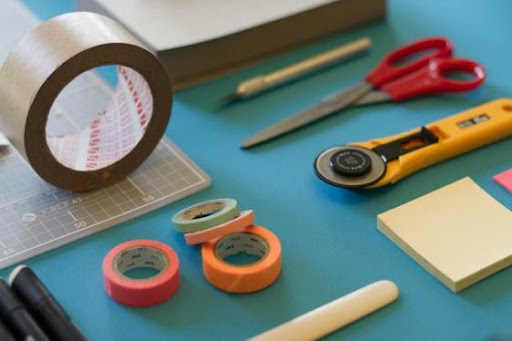
[ad_1]

If you have your own craft room in your home, lucky you! There’s nothing better than creating that dedicated space to nurture creative exploration. But all that great energy can fall by the wayside if the space becomes cluttered and difficult to navigate. Here are seven tips to help keep this sacred space in your home functional, fun and organized so that you can keep the joy-filled craft sessions going strong.
Tip #1: Start by establishing the main space
Chances are your craft room has a central area, or that spot where the creative stuff happens. It could be a large table with stools around it or even a sheet of plywood set on top of some sawhorses. It doesn’t matter if it’s rustic or the coolest table from a luxury store. What you want to do is measure it and find the best place for it. Then you can design storage and functionality around it.
Use the internet for ideas. For example, you may initially think the worktable needs to be in the middle of the room, but a visual could help you learn that a corner space with perfect window light is the better spot.
Tip #2: Keep frequently used small supplies close
The next step is to think about smaller supplies you use a lot. You’ll want to keep them close. Use storage bins and organizers for items like buttons, bottle corks, popsicle sticks, and use a larger bin for knives, scissors, markers and other hand tools.
Depending on the size of the table, you may be able to place the supply station right in the middle of it. But some people even use a roll-away wire display or storage cart they can park next to the work area. And if you don’t have the perfect bins or organizers, those tissue boxes you have saved for a project may make for great storage bins as well.

Tip #3: Use the periphery for larger items
For bulkier items like large rolls of construction paper, paint cans, paper plates, coffee filters, tissue boxes, and others, store them along the walls. If you need to use some of the larger supplies for a project, take what you need and keep the rest in your dedicated area outside your workspace. You can create a system of pull-out bins or simply use shelves. And just as many do in their garages, you can use pegboard for larger items that hang on pegs or racks.
Tip #4: Lock up hazardous supplies
If you have little ones who may have access to the room when you’re not around, you want to make sure choking, or other, hazards are out of reach. If certain items near your creative areas pose a threat, develop a routine of stowing them away in a locked drawer, cabinet or storage case after all activities are finished. And if you decide to leave items accessible, you may need to consider locking the door when you’re not working in the space.
Tip #5: Have a clean-up plan or space
Fun can be messy. If you have little Picasso’s using the space, you’ll want to keep certain cleaning supplies close by. And a designated clean-up zone, if you have the room, can help. If you have sink access, all the better. If you don’t have a sink, keep towels and cleaning supplies in nearby bins or on a rolling cart so you can tend to spills and drops. Some craft rooms even have their entire worktables on rollers so they can slip drop cloths under them.
Tip #6: Try furniture that doubles as storage
If your worktable has room for benches, look for ones that have storage space underneath them. Think about storage with other furniture pieces as well. Large tables that can serve as the main creative area, but that have pull-out drawers or bin systems built into them can help. A hutch that can serve as an impromptu desk with storage compartments in it, and even simple cabinet pieces that are deep enough to build storage on top of, could be beneficial.
Tip #7: Leave room for show pieces
Your craft room doesn’t have to be all work and no play. Leave room in areas to display that cool tissue box monster face on a stylish, secure stand. Or use a display case to show off your whole family’s latest creative efforts. If craft projects are done often in your home, keep changing the displays, and don’t be afraid to show off your works in other parts of the home to add to the décor.
As you organize, keep in mind that good organization serves your creativity. Easy access to supplies can free the mind so that you can put more energy into the project in front of you. And if you have systems in place for set up and clean up, it’s easier to enjoy some worry-free fun.
Author Bio
Ray Ko has been creating effective visual merchandising and interior design strategies for retailers for more than 20 years. Today, he is the senior ecommerce manager for shopPOPdisplays, a leading designer and manufacturer of stock and custom acrylic product
[ad_2]
Source link






